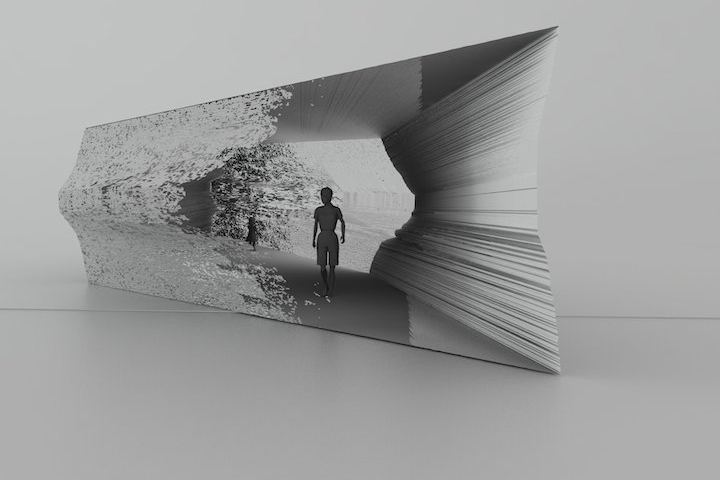the transformation of architectural form
Abstract
‘Meta predictive matter’ is a project that addresses the transformation of architectural ‘form’ into an ‘image’ and vice versa. The main focus lies on the interplay between the perception of space, form generation and its material manifestations and how this can inform the design process across multiple scales. The study investigates how to bring the programmability and polymorphism of digital forms into the physical world, by revising analytical design tools and matching them with computational tools for data analysis. The aim is to promote a performance based design approach within the context of material aware fabrication.
Introduction
As we stand on the threshold of a world defined in terms of digitally generated realities we need to consider more carefully than ever before the question of space and the nature of its reality (Woods,2002). We are observing a rapid change in the way space is being perceived and mediated, which is a direct consequence of advances in information and computational technologies. The data handling capacities of computers, the cutting edge analysis techniques and the custom developed software allow designers to address much more complex problems than ever before. As a result, a broader solution space can be explored, the designers gain access to massive data libraries and direct collaboration among different disciplines is facilitated. This requires a whole new set of design techniques, but, most importantly, new mind sets which enable algorithmic thinking and even a new level of cognition and understanding of space. Apart from mere geometrical representations, computational models become the new interfaces between different domains, where information science and mathematics respectively, play a crucial role. Models slowly become a new medium of experience, exploration and learning at the same time, revealing different levels of complexities.
In order to formulate a new design approach, in this context, there is a need for a paradigm shift towards a more participatory and open design system, where the designer’s intentions are informed by easily accessible data, relating to user behavior and where design intuition is combined with analytical tools. Nowadays, architects can handle apart from non-Euclidean geometries, multi-dimensional data-sets and they can develop custom design systems.
Thus, this study suggests reconsidering the notion of design-thinking and speculates on novel ways of conceptualizing and producing architecture. It regards space as a scalar field of activities performed within it and uses as its reference system an abstraction of space, as it is experienced by its users. In this way, it promotes a methodology of performance-informed form generation by means of computational geometry. It particularly focuses on: a) gaining insight in the intractable design relationships that cannot be modeled using conventional associative methods and b) addressing both the possibilities in concept generation and the challenges in the translation from design to construction.
Design intentions and objective
The project is built upon the idea that the activities performed in a specific space are mainly based on the user’s intuition within the available environmental context (light, sound etc). This intuitive human choice is suggesting a topological relationship of spaces, making activities an abstraction of architectural space or indexes of any existing spatial setup.
As information technologies become dematerialized – paradoxically becoming more intense – the typical program ceases to have a one-to-one relationship with the technologies that function within it (Reiser and Umemoto, 2006). Driven by recently emerging global phenomena, political, economical and social ones which are based on user behavior and which would not have been possible without ubiquitous computing and easily-accessible data transfer, we draw our interest in how such phenomena could be integrated in the design process and possible ways of bridging the gap between those who use a space and those who design it. The research draws upon work done on the field of analysis of multi-dimensional datasets, like Principal Component Analysis (PCA) and Self Organizing Maps (SOM), and attempts to utilize them for design purposes. The algorithmic definitions of the design operator were developed in Java programming language, while the experiments for the realization of the design outcomes were conducted using different additive manufacturing technologies.
The project was conducted from September 2012 till March 2013 at the Chair for Computer Aided Architectural Design at ITA of ETH Zurich, under the supervision of Professor Ludger Hovestadt, Manuel Kretzer and Hua Hao, by the students Styliani Azariadi, Evangelos Pantazis and Daniel Rohlek. The project is still under development and partially funded by the Ikea Foundation of Switzerland and by the LG Hausys/ Hi-MACS company.












